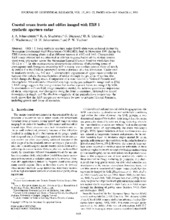Coastal ocean fronts and eddies imaged with ERS 1 synthetic aperture radar
Johannessen, Johnny A.; Shuchman, Robert A.; Digranes, G.; Lyzenga, D. R.; Wackerman, C.; Johannessen, Ola M.; Vachon, P. W.
Peer reviewed, Journal article
Permanent lenke
https://hdl.handle.net/1956/813Utgivelsesdato
1996-03-15Metadata
Vis full innførselSamlinger
- Geophysical Institute [1228]
Originalversjon
https://doi.org/10.1029/95jc02962Sammendrag
ERS 1 C band synthetic aperture radar (SAR) data were collected during the Norwegian Continental Shelf Experiment (NORCSEX) both in November 1991 during the ERS 1 commissioning phase and at different seasons in 1992 and 1993. Characteristic SAR image expressions are observed in relation to perturbation of the surface current-short wave interaction across the Norwegian Coastal Current front for winds less than 10–12 m s−1. In situ measurements document the existence of alternating zones of convergence and divergence coexisting with a strong near-surface current shear of nearly 4f (where f is the Coriolis parameter) across a distance of a few kilometers. Under calm to moderate winds, i.e., 4–7 m s−1, characteristic expressions of upper ocean circulation features also include the manifestation of eddies through the presence of surface film, which damps the Bragg waves. Comparison of a near-coincident National Oceanic and Atmospheric Administration advanced very high resolution radiometer image and an ERS 1 SAR image supports the interpretation that surface current fronts are imaged by SAR. In combination with a SAR image simulation model, the relative quantitative importance of shear, convergence, and divergence along the front is examined. Although the model formulation is simple and the absolute magnitude of the perturbations is uncertain, the study shows that the SAR images can sometimes be used to interpret frontal dynamics, including growth and decay of meanders.
